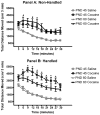Cocaine-induced locomotor activity is increased by prior handling in adolescent but not adult female rats
- PMID: 16176824
- PMCID: PMC5533576
- DOI: 10.1016/j.physbeh.2005.08.026
Cocaine-induced locomotor activity is increased by prior handling in adolescent but not adult female rats
Abstract
Adolescence is a period of transition that is associated with increased levels of stress and a heightened propensity to initiate drug use. Neuronal development is still occurring during this transitional period, which includes the continued development of the dopamine system during the adolescent period. In the present study, the effects of pre-test handling on cocaine-induced locomotor activity were investigated among female adolescent and young adult rats upon presentation to a novel environment. On postnatal days (PND) 41-44 and 56-59 animals were handled (b.i.d.) in the colony room for 3 min. On PND 45 or PND 60, animals were removed from the colony room, weighed, and administered an acute injection of either cocaine or saline and presented to a novel environment where behavior was recorded for 30 min. Adolescent females (PND 45) that were handled prior to cocaine administration demonstrated elevated levels of cocaine-induced activity relative to their age-matched non-handled counterparts and also to their handled-adult counterparts. In contrast, among non-handled animals, young adults (PND 60) exhibited elevated drug-induced locomotion at several time points during the trial. Non-handled adolescent animals demonstrated the previously described "hyporesponsive" behavioral profile relative to their non-handled adult counterparts. The results from the present experiment indicate that adolescent animals may be more sensitive to basic laboratory manipulations such as pre-test handling, and care must be taken when utilizing adolescent animals in behavioral testing. Handling appears to be a sensitive manipulation in elucidating differences in cocaine-induced behavioral activation between ages.
Figures


Similar articles
-
Handling alters cocaine-induced activity in adolescent but not adult male rats.Physiol Behav. 2005 Feb 15;84(2):321-6. doi: 10.1016/j.physbeh.2004.12.007. Epub 2005 Jan 13. Physiol Behav. 2005. PMID: 15708784 Free PMC article.
-
Effect of MDMA (ecstasy) on activity and cocaine conditioned place preference in adult and adolescent rats.Neurotoxicol Teratol. 2007 Jan-Feb;29(1):37-46. doi: 10.1016/j.ntt.2006.09.002. Epub 2006 Sep 14. Neurotoxicol Teratol. 2007. PMID: 17049207 Free PMC article.
-
Developmental lead exposure alters the stimulatory properties of cocaine at PND 30 and PND 90 in the rat.Neuropsychopharmacology. 2000 Oct;23(4):444-54. doi: 10.1016/S0893-133X(00)00118-4. Neuropsychopharmacology. 2000. PMID: 10989272
-
Heightened cocaine-induced locomotor activity in adolescent compared to adult female rats.J Psychopharmacol. 2005 Sep;19(5):443-7. doi: 10.1177/0269881105056518. J Psychopharmacol. 2005. PMID: 16166180 Free PMC article.
-
Influence of early postnatal rearing conditions on mesocorticolimbic dopamine and behavioural responses to psychostimulants and stressors in adult rats.Eur J Neurosci. 2004 Apr;19(7):1863-74. doi: 10.1111/j.1460-9568.2004.03286.x. Eur J Neurosci. 2004. PMID: 15078560
Cited by
-
Early adolescents show enhanced acute cocaine-induced locomotor activity in comparison to late adolescent and adult rats.Dev Psychobiol. 2008 Mar;50(2):127-33. doi: 10.1002/dev.20252. Dev Psychobiol. 2008. PMID: 18286579 Free PMC article.
-
Patterns of neural activity associated with differential acute locomotor stimulation to cocaine and methamphetamine in adolescent versus adult male C57BL/6J mice.Neuroscience. 2010 Feb 17;165(4):1087-99. doi: 10.1016/j.neuroscience.2009.11.038. Epub 2009 Nov 22. Neuroscience. 2010. PMID: 19932887 Free PMC article.
-
Evaluation of a pharmacokinetic hypothesis for reduced locomotor stimulation from methamphetamine and cocaine in adolescent versus adult male C57BL/6J mice.Psychopharmacology (Berl). 2009 Jan;201(4):589-99. doi: 10.1007/s00213-008-1327-0. Epub 2008 Sep 17. Psychopharmacology (Berl). 2009. PMID: 18797848
-
Acute locomotor responses to cocaine in adolescents vs. adults from four divergent inbred mouse strains.Genes Brain Behav. 2010 Nov;9(8):892-8. doi: 10.1111/j.1601-183X.2010.00630.x. Genes Brain Behav. 2010. PMID: 20662938 Free PMC article.
-
Reinstatement of cocaine seeking induced by drugs, cues, and stress in adolescent and adult rats.Psychopharmacology (Berl). 2010 Feb;208(2):211-22. doi: 10.1007/s00213-009-1721-2. Epub 2009 Dec 2. Psychopharmacology (Berl). 2010. PMID: 19953228 Free PMC article.
References
-
- Johnston LD, O’Malley PM, Bachman JG. Monitoring the Future national results on adolescent drug use: overview of key findings, 2002. Bethesda, MD: National Institute on Drug Abuse; 2003. (NIH Publication No. 03-5374)
-
- Laviola G, Macri S, Morley-Fletcher S, Adriani W. Risk-taking behavior in adolescent mice: psychobiological determinants and early epigenetic influence. Neurosci Biobehav Rev. 2003;27:19–31. - PubMed
-
- Spear LP. The adolescent brain and age-related behavioral manifestations. Neurosci Biobehav Rev. 2000;24:417–63. - PubMed
-
- Estroff TW, Schwartz RH, Hoffmann NG. Adolescent cocaine abuse. Addictive potential, behavioral and psychiatric effects. Clin Pediatr (Phila) 1989;28:550–5. - PubMed
-
- Chin J, Sternin O, Wu HB, Fletcher H, Perrotti LI, Jenab S, et al. Sex differences in cocaine-induced behavioral sensitization. Cell Mol Biol (Noisy-le-grand) 2001;47:1089–95. - PubMed
Publication types
MeSH terms
Substances
Grants and funding
LinkOut - more resources
Full Text Sources

